Inside the Corsair Obsidian 550D
Sound deadening was definitely added to the side panels. It covers edge to edge and top to bottom, you can even see where it gets smashed against the frame to isolate any chatter there as well.
The first look inside shows that the wiring is both tied together as well as being covered in padding so when they flop around they don’t get damaged. As for the hardware, that can be found in the white box in the lowest HDD tray.
In the front you get a rack capable of holding four 5.25″ drives. Each bay has its own tool-less clip that allows the drive to slide in. Simply press that tab to release the pins and the drive will slide back out.
The two section drive assembly for storage drives holds up to six, either 2.5″ (with screws) or 3.5″ drives (with pins) or any combination of those. The trays slide in and out easily and do lock well into place.
You can remove just the top section to leave room for dual GPU video cards or just to allow the 120mm fan to blow on the card instead of the case. Also the bottom section can be removed, top, bottom, one, two, none; it’s all in your hands.
The motherboard tray is recessed where the Micro-ATX or ATX motherboard sits. Around it the tray is inset more to allow room for wires where it’s needed. There are five wire management holes, four with grommets and a few places to tie up wiring.
The replaceable expansion slot covers are held in place with thumbscrews with a cut out in the case frame for access. There is also a gasket in the PSU mounting to keep that area sound isolated as well.
As for the included chassis wiring, things are kept basic and black. There are three 3-pin fan headers to connect, HD Audio, USB 3.0 and the various control and LED wires.
Behind the actual motherboard, space is limited to right around 10mm, or just enough to pass the 8-pin EPS cable through. To the left and under it, there is plenty of room to hide multiple layers of wires as you will see soon enough.
Corsair Obsidian 550D Mid-Tower Chassis
The front of the chassis is mainly flat across the front, but does take an angled bend near the edges of this brushed aluminum panel that is diamond cut to surround the front I/O panel. Even though small, the Corsair name and logo grace the lower section of this panel.
Included in the front I/O are the 3.5mm microphone and headphone jacks next to the tiny reset button. In the middle is a backlit power button denoting case power with an HDD activity light just above it to the left. This leaves the pair of USB 3.0 ports to complete the list.
With the use of special clips and a set of pins in the front bezel on either side, it allows this aluminum panel to open to the right…
… or to the left. There are no special tricks, simply release the clips on the side you want to open and it swings freely in that direction. The panel can even be outright removed if you want it to be out of the way altogether.
As we step back a bit you can see both the side and the top have what seem to be removable panels and they are. These covers are plastic and with a push on the designated areas…
… you hear a click as the latch releases and both covers can be removed to allow the chassis the benefit of more air flow with optional fans.
Both the top and this side of the «fan area» are treated in the same fashion. Both plastic covers are backed with sound deadening material as well as the chassis having a dust filter for these sections included with the case. Both sections are also set up to allow 120mm, 140mm or 200mm fans.
The back has a 120mm fan installed, but can also take on a 140mm fan and there are eight expansion slots above the large hole for the PSU. There are four holes with grommets that will allow the easy passage of water cooling tubes.
To remove the doors on this chassis, both sides at the top have these square door release buttons. As it plainly says, you just push this button in and the door will open at the top for you.
The right side panel is plain and offers nothing worth mentioning other than the way it opens. Hiding wires is much easier with a panel that sets on the bottom rail and closes as you click the top into the locks.
Under the chassis there is solid rubber feet that supports the chassis and the front feet connects the front bezel to the case, keep that in mind. In the steel you get a PSU ventilation area, a spot for an extra fan location for a 120mm or 140mm, covered with a dust filter. In the front there are four thumbscrews that hold the HDD rack in place.
Final Thoughts
Hopefully by now you can see why I was so eager to bring this to you in hopes that you would see my point of view. I mean there is very little in the «this case doesn’t have…» category, especially at this price range.
Like I said, we have seen silent case, cases with front doors and even many other cool creations from Corsair since I got my 800D, but this case is the first to take me back to that warm and fuzzy feeling. For a case to take on the role of a silent chassis, sound proofing and redirecting the intakes air flow from the front to the sides are all things that we expect. Not many offerings in this category offer you the option for five extra fans, but you can now go with a high air flow build. Then of course there is usually the most important thing in all case designs and that is the aesthetics. With the sleek design, simple lines and a bit of elegance, the Corsair 550D fails on none of those levels.
I made mention earlier that the build just seemed to happen and I wasn’t joking, well not all that much anyways. I do remember putting in the motherboard and the PSU, but the rest is a haze of just adding components, plugging it in and letting the wires fall where they may. I did spend about 20 minutes behind the tray tidying things up, but still the time was well worth it as this build looks good behind the scenes as well as in the main compartment.
Once I got to the testing phase, I went with the «as shipped» configuration and I thought I had an issue with my build. I could see the light was on behind the power button and there was a quick flicker of the HDD light, but I just could not hear anything running. I actually went around the room making sure it was the only thing powered up besides the lights and I still couldn’t hear anything. I literally had to go around to the back of the chassis for any sort of noise coming from the chassis and even then it was very minimal.
In the end, I am really grasping the line built by builders, for builders, as this chassis is a prime example of that concept. I mean you can take any case on the market today and try all you can to compare it to this design, but in the end, I’m pretty sure your solution will fall short in some if not a few aspects of the design of the 550D.
What helps tremendously is that with the price I can find this chassis currently, at just less than $140 (to your door); this is a case anyone can own. I really don’t think it matters that I build in cases for a living, or if it is the first time novice builder, no matter who builds inside of this chassis, you are going to love the options to change the chassis with your needs as time goes on, or if you use it as delivered, it will be a long time before this case needs to be replaced.
It’s as solid of an investment as I can see right now in the mid-tower market as any other out there.
Accessories and Documentation
Included in that white hardware box that was in the HDD bay, Corsair includes a USB 3.0 to 2.0 adapter, a bag with wire tending goodies and two bags with extra clips for the front panel.
All separated in individual bags you get fan screws, PSU screws, extra risers, drive screws, long fan screws for the front, motherboard screws and another set of smaller fan screws.
The installation guide on the left gives an included parts list and instructions around an image like that on the back of the chassis packaging. The chassis is very intuitive though and there was only one hidden surprise that took me a second to figure out.
On the right is the «STOP» paper telling you to deal with Corsair directly for any issues and not the reseller.
Подсветка
Для управления оборотами вентиляторов и их подсветкойв Mid-Tower корпусе Corsair Obsidian 500D RGB необходимо будет установить фирменную утилиту iCUE. После запуска в самой утилите появится устройство Commander Pro, которое и отвечает за работу всех элементов внутри корпуса. Интерфейс русскоязычный и простой. Настроек для данного устройства не так много:
1. «Конфигурация» позволяет выбрать один из трех готовых профилей работы вентиляторов: тихий, сбалансированный или производительный. Можно также создать пользовательский (постоянные обороты, заданный % от оборотов). Все изменения отображаются в основном окне, где показываются обороты и рабочие напряжения.
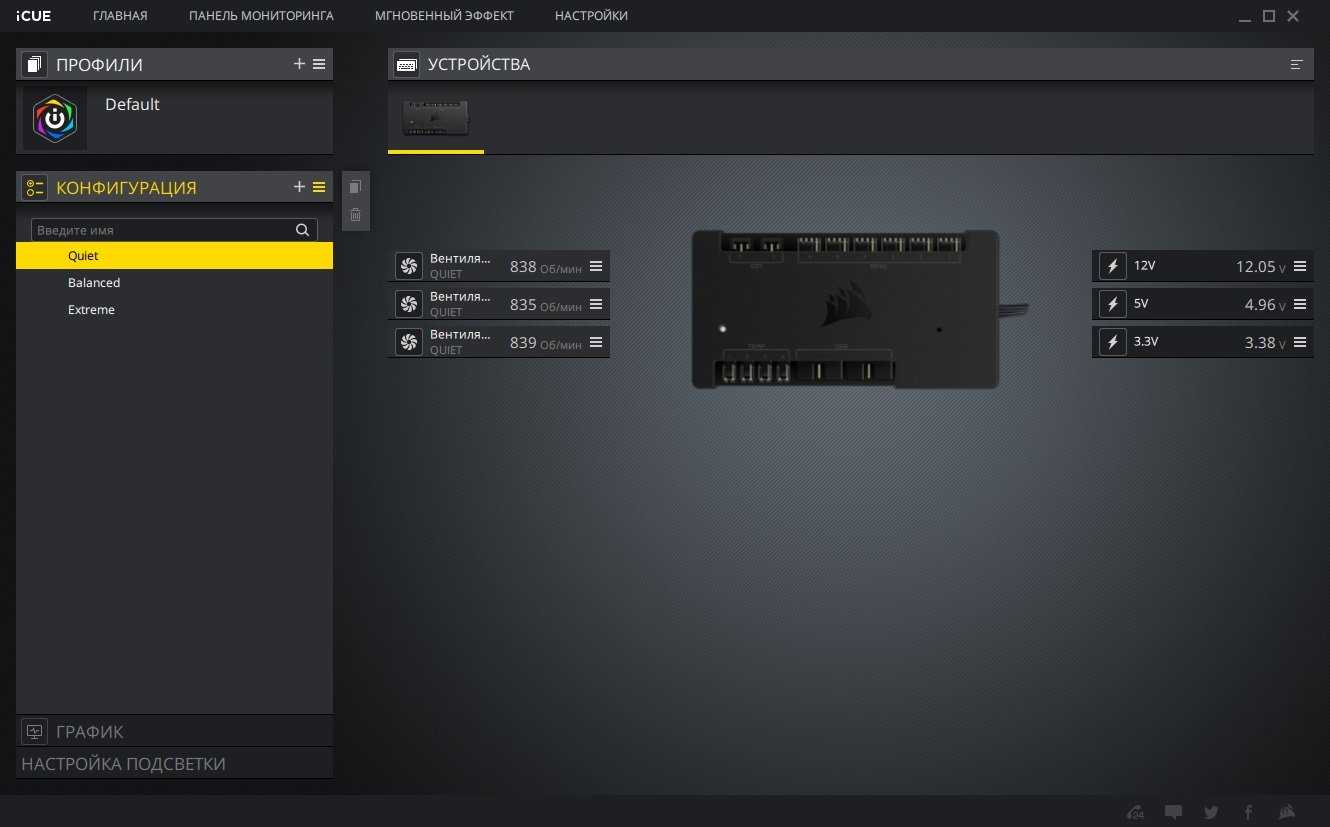
2. «График» позволяет контролировать изменения параметров.
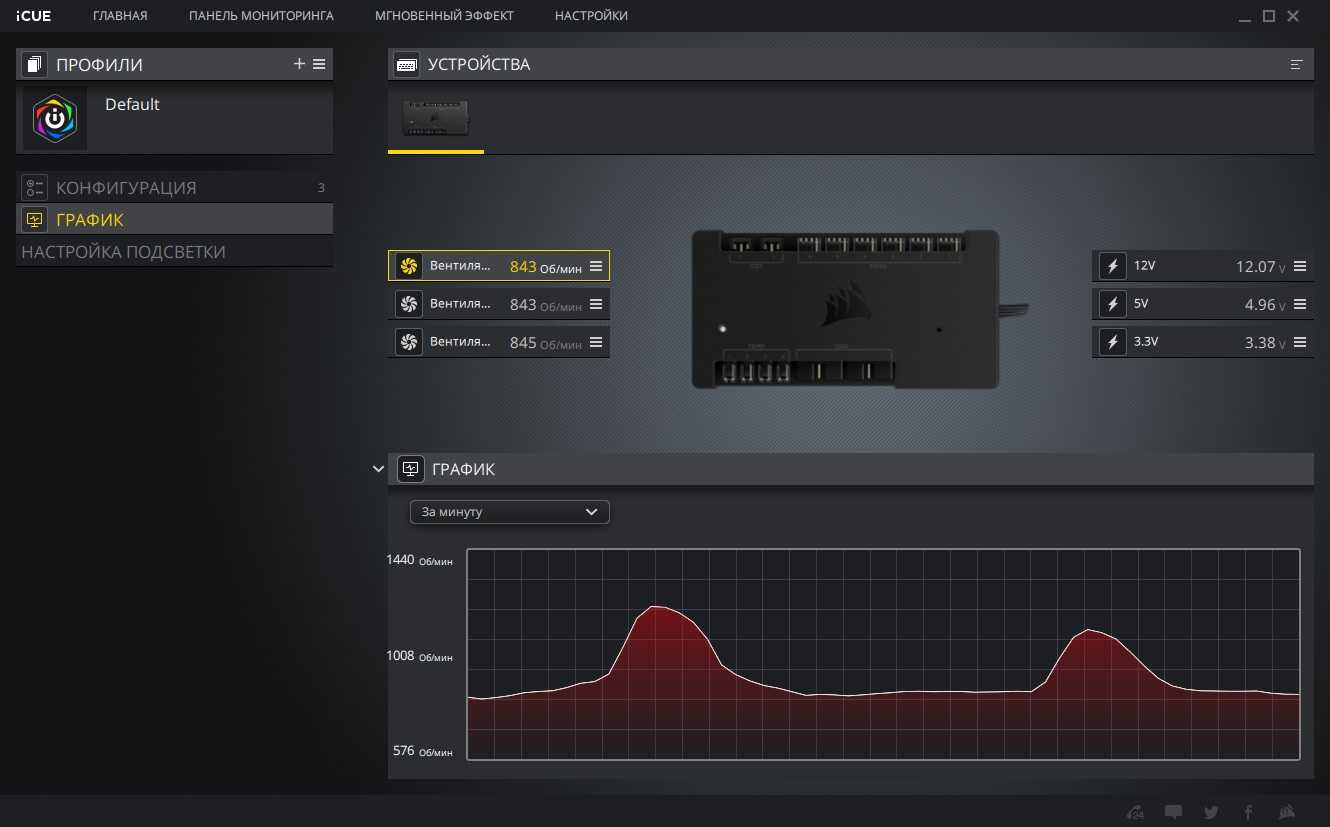
3. «Настройка подсветки» позволяет выбрать правильный тип и количество вентиляторов для корректной работы подсветки. Возможности в плане эффектов те же, что и в обзоре корпуса Corsair SPEC OMEGA-RGB. Эффектов много.
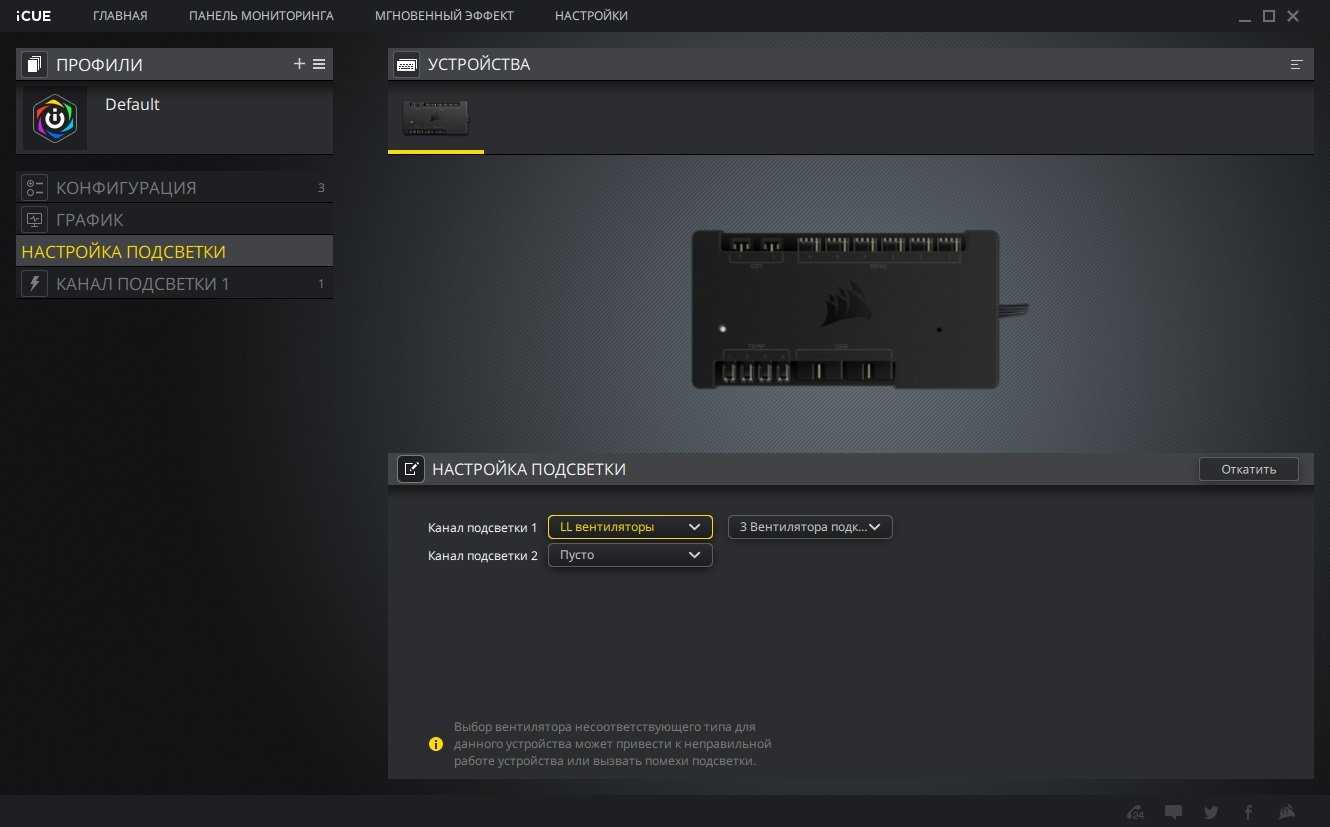
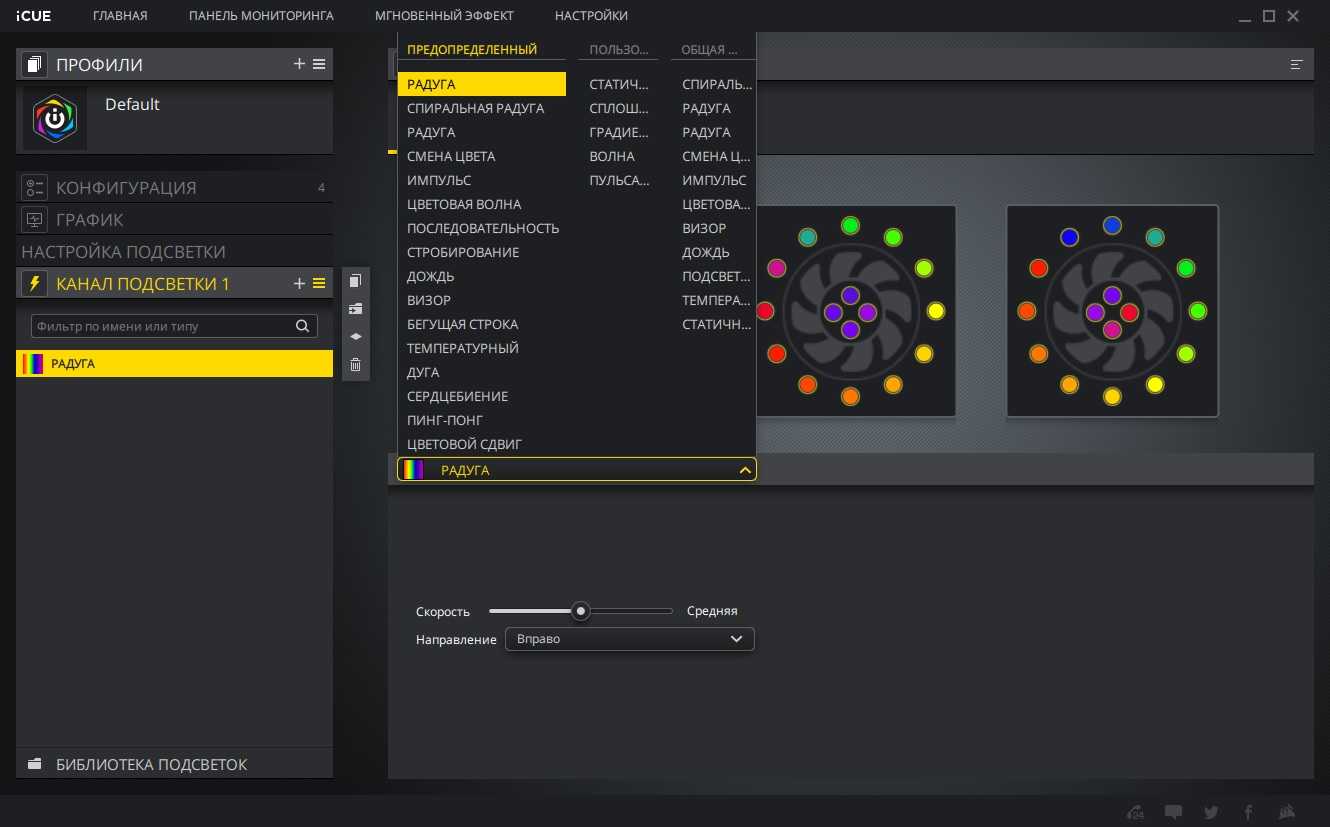
В «Панель мониторинга» можно вывести те параметры, которые необходимо контролировать.
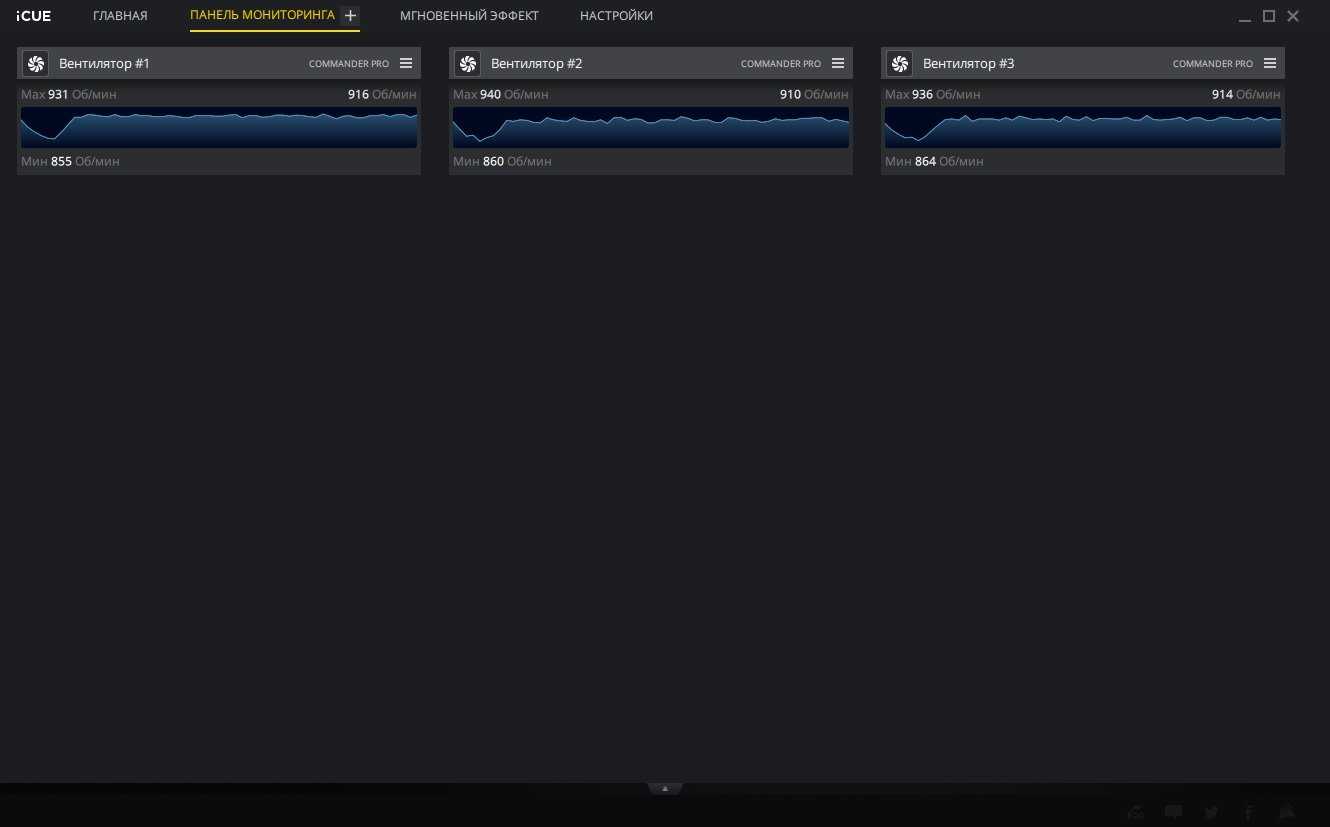
При необходимости, через раздел «Мгновенный эффект» можно быстро выбрать один из нужных статических цветов.
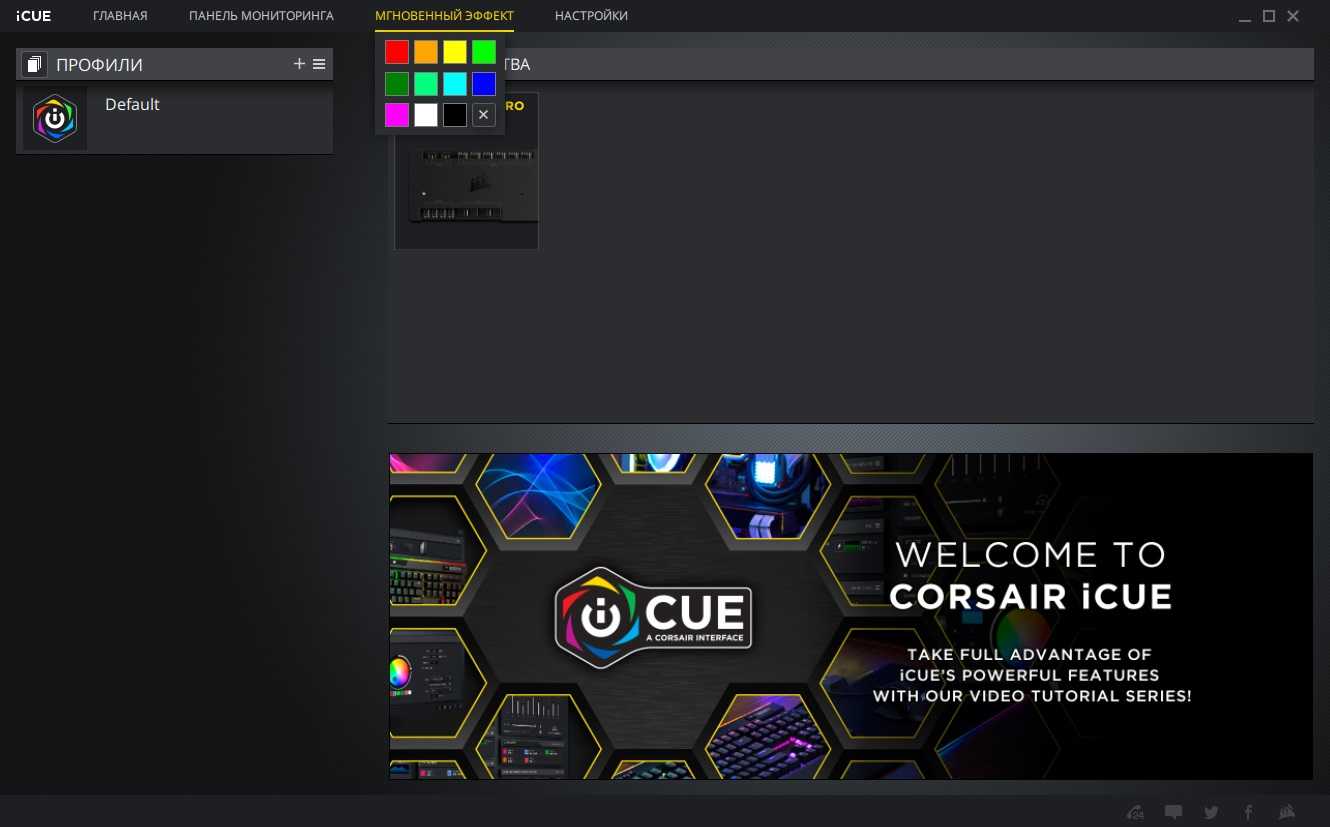
Результаты тестирования
Нагрев компонент.Простой системы.
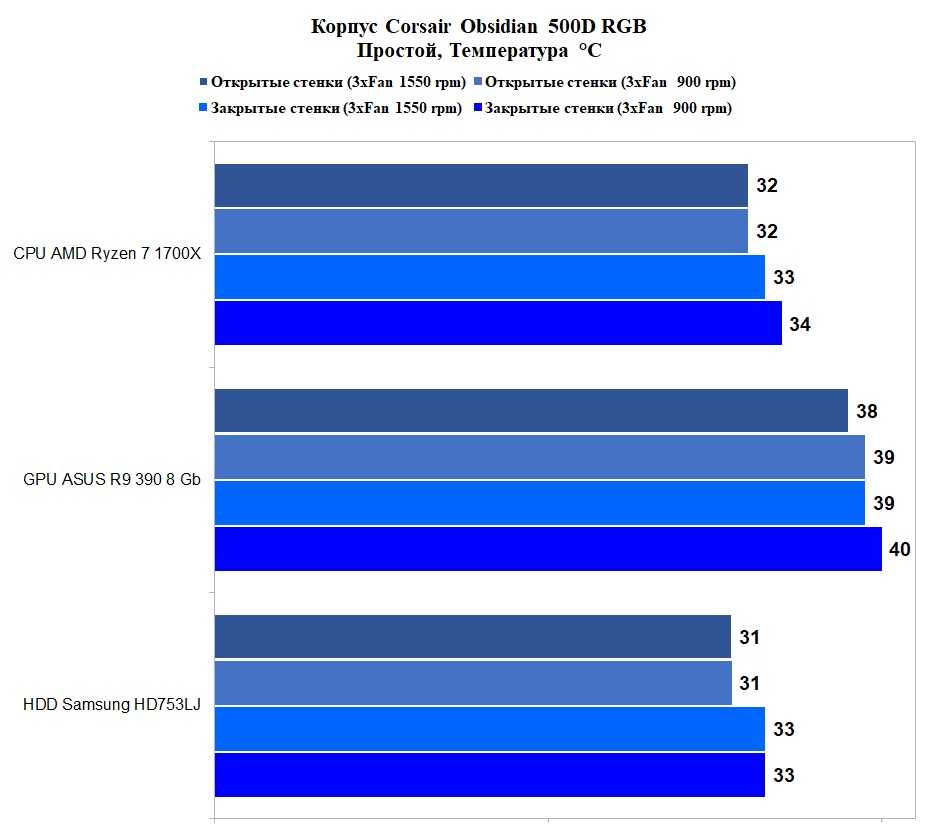
Работа в простое уже заставляет вспомнить об особенностях работы накопителей за поддоном без охлаждения; разница в нагреве жесткого диска Samsung достигает 2 °С.
Нагрузка системы.
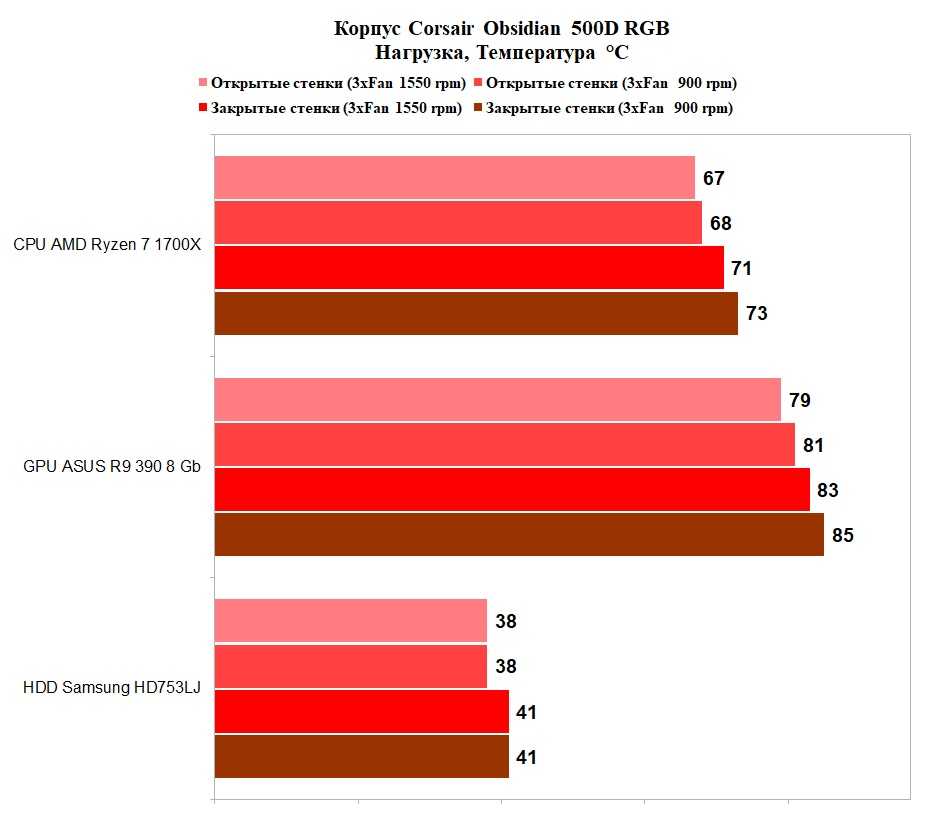
Если говорить о работе под нагрузкой, то обратим внимание на повышенный нагрев процессора и видеокарты в закрытом корпусе относительно открытого. Так, для процессорапри одинаковых оборотахона составляет 4 °С и 5 °С соответственно, для видеокарты – 4 °С
Причина такого разброса кроется в недостаточном отводе нагретого воздуха за пределы корпуса, так как на задней стенкеи тем более сверхунет предустановленных вентиляторов. Но это только говорит о желательной установке вентилятора на задней стенке. В целомнагрев комплектующих получился умеренным.
Уровень шума.
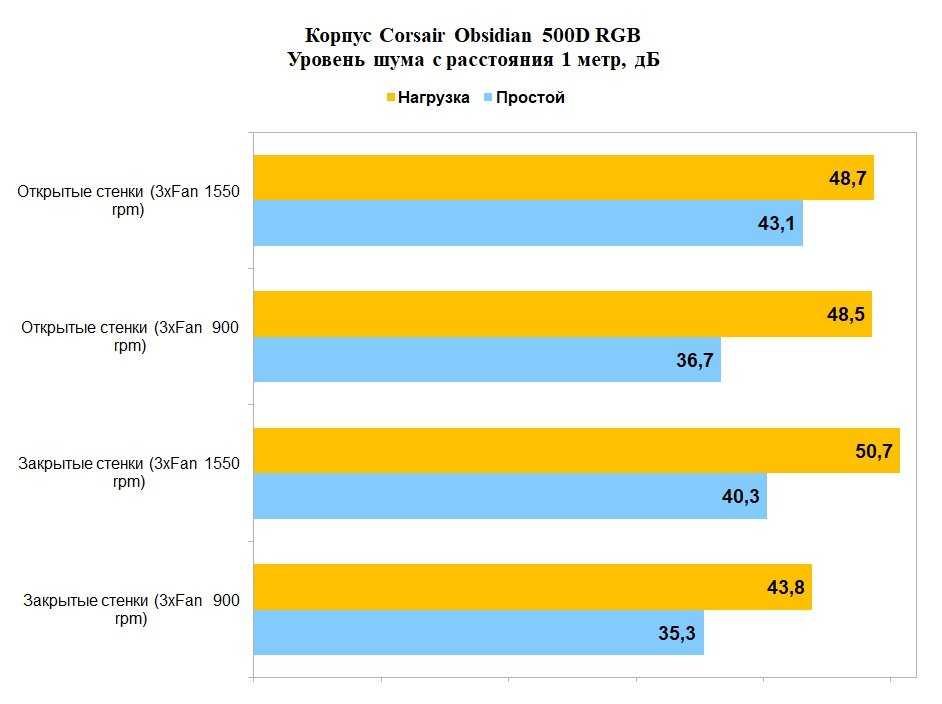
Относительно тихая работа корпуса возможна только в простое при оборотах штатных вентиляторов до ~1000 rpm. При более высоких они начинают выделяться своим шумом, а при 1500 rpm и выше вполне способны «перекрыть» шум от работы других систем охлаждения корпуса.
Packaging
Helping to keep the pricing low and leaving more of it to go into the design, Corsair ships this Obsidian chassis in a plain brown box with black printing on it. Here we get a drawing of the 550D and next to it six languages containing a description of what went into the design and why you should buy this case over others.
On this side we have the name of the company and the chassis filling the top and renderings of the front and inside of the chassis at the bottom. In the middle are three specs charts.
On the back of the box you get an exploded view of the chassis with the letters A through K denoting things of interest. At the bottom there is text in six languages to give a brief description of each of the noted features.
On this side of the box we see it repeats the other side, but this time the charts are in three other languages.
Corsair used the «typical» inner packaging with the use of a plastic liner and Styrofoam end caps, but they didn’t stop there. To help protect the aluminum front and the side ventilation panel, there are two pieces of thick cardboard inserted. You will see soon enough that it resulted in a perfect sample being delivered to me.
Taking it even one step further Corsair has a coating of plastic applied to the front and tapes the side panel and drive bay covers to ensure they stay in place. The arrows on the face plate are to denote the swing of the door and notice it has arrows going in both directions.
Specifications, Availability and Pricing
The specifications chart looks kind of bare for all the hype I just talked about the 550D, but let’s cover this section and then I can move on to the hidden goodies.
The 550D is all steel, but uses ABS plastic for tool-less clips, drive trays and the frame of the front bezel. To spice things up a fair bit, a sleek and simple, brushed aluminum panel gets anodized black and works as the front swinging door of this mid-tower. Inside the chassis supports both ATX and Micro-ATX motherboards and has eight expansion slots in the back. in the front you have a set of four 5.25″ bays with tool-less clips and room for up to six 3.5″ or 2.5″ drives via the cage and tray system incorporated in the 550D that is also half or fully removable.
The cooling is handled with three black 120mm fans, the same ones that come in all the Corsair cases. It doesn’t stop there, however. Also designed into the chassis are two removable panels to allow air flow into the left side of the chassis and/or out of the top of the chassis. That brings the total of fans to use in this chassis up to seven and we haven’t even covered that there is room for 200mm fans if you should choose to install them.
On the flip side of that coin, as the case is shipped, the removable panels, inside of the front of the case and the entirety of the door panels are covered in sound isolating material. So with all the sound proofing in place, there isn’t a peep, hum, or a buzz to be heard coming from the chassis. I have seen this sort of thing before, but rarely does any company think about sound levels and air flow in the same design — usually one comes at a high cost to the other, here that simply isn’t true.
If you are one of the many I think are going to seriously buy this chassis, I do suggest you shop around a bit. Directly from Corsair you can find the 550D listed at $159.99 and we haven’t even added in the shipping yet. Tasking an extra few seconds to get Google on line and type in the case name, it doesn’t take long to see that the top ten listings all beat the MSRP that Corsair is showing on their site.
Amazon and Newegg are both listing the chassis for $139.99 with free shipping as I write this, so right off the bat those few precious seconds just saved you $20. There are literally tons of places to purchase one, so even though I know quite a few of my readers will be going to locate these, it won’t be any issue at all to get one to your door in a reasonable amount of time. On the biased opinion side of things, for $139.99 you are going to be hard pressed to find a case so willing and accepting of any sort of configuration or build you plan to do.
The line «Designed by builders, for builders» really rings true in this chassis design.
A revolutionary combination of noise reduction and cooling.
Obsidian Series 550D is carefully engineered for noise reduction and sound isolation. But, it’s not just about keeping things quiet — there’s amazing cooling potential, lots of expansion flexibility, and the durability that Obsidian Series is renowned for.
Stamped steel meets rugged aluminum for a look that’s subtly elegant.
Superior airflow for high-performance PCs.
Obsidian Series 550D comes with two front-mounted 120mm intake fans and one 120mm exhaust fan – more than enough for delivering the airflow required for a high-performance system. But if you’re pushing past high performance and into the realm of extreme-performance overclocking, there’s room for a lot more. The top panel provides room for two 120mm or 140mm fans, or a 240mm radiator for compatibility with Corsair Hydro Series CPU coolers and other liquid cooling systems. The side panel has mounting points for another two 120mm or 140mm fans for cooling multiple GPUs. In total, the 550D offers ten 120mm fan mounting points, six of which can also accommodate 140mm fans.
The silent treatment.
With many high-end PC cases, cooling is often provided without consideration for noise. Not so with the 550D: the front and side panels are fully lined with sound-damping material, and the top and side panels have their own sound-insulated vent covers to reduce noise leakage from unused fan mounting locations. The front air intakes are angled away from the front of the case for noise reduction, and the fans and drive bays use silicone mounts to reduce vibration noise. The result is a platform for building high-performance PCs you can live with.
The diamond-cut aluminum front panel includes two USB 3.0 connectors and audio connectors.
Smart features for serious builders.
The extra touches like magnetically mounted dust filters and one-button side panel removal make building fun, and using a 550D-based system a rewarding experience. Expansion is easy, with eight expansion slots, six tool-free hard drive bays with removable caddies and integrated 2.5” SSD support, and four tool-free optical drive bays. The top drive cage can be removed to accommodate GPUs of up to 452mm in length. The diamond-cut brushed aluminum front panel houses two high-speed USB 3.0 connectors and audio ports.
Страница 1: Тест и обзор: тихий корпус Corsair Obsidian Series 550D
Corsair начинает всё боле активно проявлять себя на сегменте корпусов. И компания продолжает расширять ассортимент своих корпусов. В случае Obsidian Series 550D мы получили первый тихий корпус Corsair на рынке, на основе которого можно собрать очень тихий компьютер. Кроме того, корпус выглядит элегантно благодаря алюминиевой передней панели, да и оснащение приличное. Но сможет ли Obsidian Series 550D достойно конкурировать с популярными моделями?
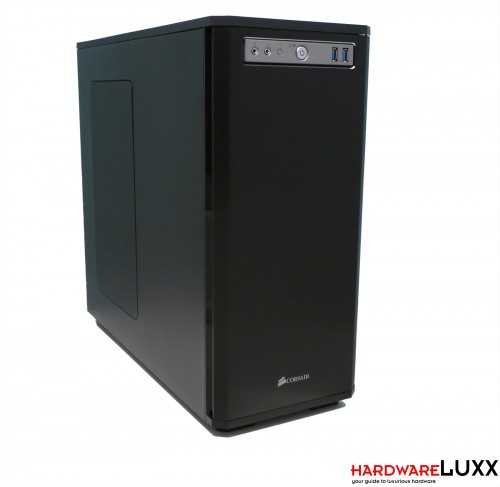
» Fotostrecke
Линейку Obsidian Series компания Corsair позиционирует на верхний сегмент рынка. Номинально корпус 550D относится к нижней части иерархии в семействе, но благодаря доработке для снижения уровня шума и изменению дизайна последний корпус Corsair вряд ли стоит напрямую сравнивать с предыдущими моделями в семействе Obsidian Series, а именно 650D, 750D и 800D. Так что корпусу в ассортименте продукции Corsair уготовлена особая роль.
Конечно, у конкурентов тоже есть схожие тихие корпуса. Fractal Design предлагает модель Define R3 (3 900 руб. в России), которая уже стала классикой тихих корпусов. Частично это связано с отличной гибкостью сборки, предоставляемой корпусом. В нём присутствует множество креплений для установки дополнительных вентиляторов в верхней и боковых панелях, которые в штатном комплекте поставки закрыты звукопоглощающими ковриками. Но если требуется, то вы можете установить в эти крепления вентиляторы, чтобы улучшить охлаждение компонентов внутри. Кроме того, Define R3 отличается сбалансированным оснащением, включая восемь 2,5″ и 3,5″ отсеков для дисковых накопителей. Antec в прошлом году тоже представила корпус SOLO II, нацеленный на тихую работу компьютера, но в отличие от модели Fractal Design перед нами не универсальный корпус, а специализированный, в котором даже раскладка оптимизирована под снижение уровня шума. В корпусе предусмотрена установка только трёх вентиляторов. А компактная стойка для жёстких дисков может вмещать только три HDD или SSD, но при этом она не так сильно мешает воздушному потоку.
Если взглянуть на спецификации Obsidian Series 550D, то сразу становится понятно, что Corsair больше нацеливалась на подход Define R3, чем SOLO II. Действительно, известный специалист по выпуску памяти выбрал формат «средней» башни с гибкой установкой вентиляторов: в штатном комплекте поставки вы получите три предустановленных вентилятора, но доступны семь креплений для установки дополнительных вентиляторов. Для накопителей места тоже достаточно: корпус предусматривает установку четырёх оптических приводов и шести HDD или SSD. Набор функций также соответствует современным стандартам — отметим безотвёрточную установку карт расширения и 3,5″ и 5,25″ накопителей, порты USB 3.0 на панели ввода/вывода, систему прокладки кабелей и окрашенный интерьер. Впрочем, среди других корпусов Midi Tower модель 550D выделяется тихой работой, включая сделанные в этом направлении оптимизации — на них мы чуть подробнее остановимся ниже в статье.
Поговорим о цене. Цена Obsidian Series 550D будет существенно выше, чем упомянутых ранее моделей конкурентов. Корпус Define R3 можно приобрести за 90 евро (3 900 руб. в России), а Antec SOLO II обойдётся в 95 евро (в России корпус ещё не появился). За новую модель Corsair в Европе придётся отдать 123 евро.
Нажмите на картинку для вывода увеличенной версии
Комплект поставки включает очень краткий информационный листок, а также пластиковые мешочки с различными аксессуарами для монтажа, несколько кабельных затяжек и переходник для подключения портов USB к обычному разъёму USB 2.0 на материнской плате.
Перед тем, как мы перейдём непосредственно к обзору корпуса, позвольте привести основную информацию в таблице:
| Основные характеристики: Corsair Obsidian Series 550D | |
| Название: | Corsair Obsidian Series 550D |
| Материал: | Сталь, алюминиевая передняя панель |
| Габариты: | 221 (Ш) x 495 (Г) x 531 мм (В) |
| Форм-фактор: | ATX, mATX |
| Отсеки накопителей: | 4x 5,25″ (внешние), 6x 2,5″ и 3,5″ (внутренние) |
| Вентиляторы: | 2x 120 (спереди), 1x 120 мм (сзади, альтернативно 1x 140 мм), 2x 120 или 140 мм (верхняя панель, опционально), 2x 120 или 140 мм (боковая панель, опционально), 1x 120 или 140 мм (нижняя панель, опционально), 2x 120 (HDD-стойка, опционально) |
| Вес: | примерно 12 кг |
| Цена: | 123 евро |
<>Тест и обзор: тихий корпус Corsair Obsidian Series 550DВнешний вид (1)
Характеристики
Corsair Obsidian 550D — впечатляющий и великолепно выглядящий корпус. Вся его передняя часть закрыта металлической дверью из матового металла, скрывающей все неприглядные отсеки для дисков. Все, что видно, — это лицевая панель с двумя портами USB3, а также разъемы для наушников и микрофона.
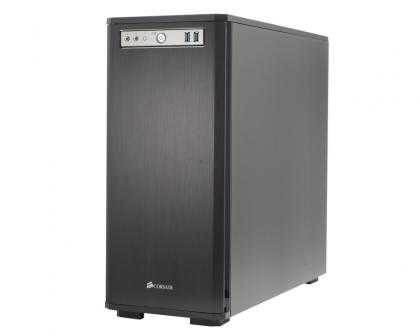
Хотя дверь, безусловно, привлекательна, она не просто выглядит хорошо, но и является практичным способом минимизации шума благодаря своему внутреннему звукоизоляционному слою. К этому присоединяется звукоизоляционная пена, покрывающая боковые стороны, верх и низ корпуса. Это, безусловно, помогает — как только мы построили наш тестовый компьютер внутри и включили его, мы едва могли услышать случай.
Охлаждение из коробки довольно хорошее, с двумя 120-мм вентиляторами спереди и одним 120-мм вентиляторами сзади. Если этого недостаточно, есть место для еще четырех 120-мм вентиляторов, шести 140-мм и 200-мм вентилятора сбоку; использование 200-мм крепления вентилятора заменяет два 140-мм вентилятора.
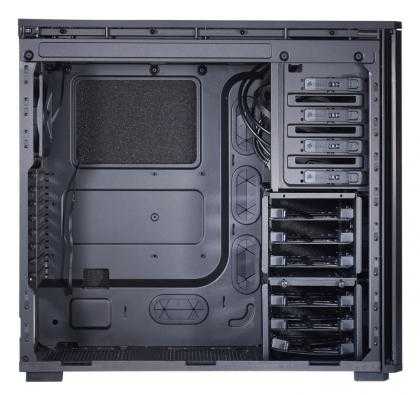
Крепления вентиляторов имеют сетчатые пылезащитные крышки, к которым очень легко добраться. Это полезно, поскольку они предотвращают попадание пыли в ваш компьютер и легко очищаются, поэтому они не предотвращают попадание воздуха в ваш компьютер.
Предварительно вырезанные отверстия в лотке материнской платы позволяют легко прокладывать кабели за пределами площадки и не допускать беспорядка во внутренностях вашего ПК. Все отверстия имеют резиновые прокладки, поэтому нет опасности зацепить ваши кабели острым металлом и надеть их насквозь.
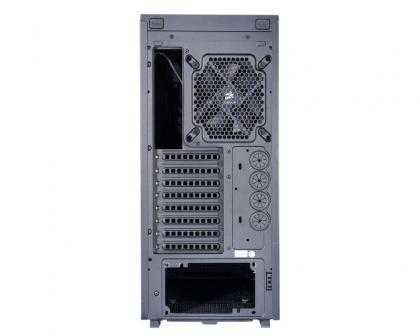
Отсеки для дисков (шесть 3,5-дюймовых и четыре 5,25-дюймовых) перпендикулярны материнской плате, поэтому кабели не будут мешать, даже если вы устанавливаете длинную видеокарту. Каждый 3,5-дюймовый отсек также может принимать 2,5-дюймовый SSD. Мы обнаружили, что отсеки без инструментов действительно просты в использовании, и они прочно закрепили наши тест-драйвы.
| Цена | £108 |
|---|---|
| Рейтинг | ***** |
| награда | Лучшая покупка |
| случай | миди башня |
| Порты USB | 2 |
| Всего портов Firewire | |
| Всего портов eSATA | |
| Порт для наушников | да |
| Порт для микрофона | да |
| Размер | 495x220x530mm |
| Вес | 7.5kg |
| Внутренние отсеки для дисков 3 1 / 2in | 6 |
| 5,25-дюймовые отсеки для дисков | 4 |
| Крепления для вентиляторов | 4×120 мм, 6×140 мм, 1×220 мм |
| Вентиляторы поставляются | 3x 120 мм |
| Поставляемый блок питания | нет |
| стандарт | N / A |
| Фанаты | N / A |
| Мощность блока питания | N / A |
| Разъем материнской платы | N / A |
| Гарантия | два года RTB |
| Цена | £108 |
| поставщик | http://www.amazon.co.uk |
| подробности | www.corsair.co.uk |
Технические характеристики
- Модель: Corsair Obsidian 500D RGB;
- Тип: Mid-Tower;
- Размеры: 507 мм (Высота) х 233 мм (Ширина) х 500 мм (Глубина);
- Вес: 11,75 кг;
- Материал: сталь, алюминий, закаленное стекло;
- Поддержка материнских плат: mini-ITX/mATX/ATX;
- Слотов расширения: 7;
- Система охлаждения:
- Предустановленные вентиляторы:спереди 3 x 120 мм LL120 RGB;
- Места под вентиляторы: спереди 3 х 120 мм или 2 х 140 мм, сзади 1 х 120 мм, сверху 2 х 120/140 мм;
- Места под радиаторы СЖО: спереди 1 х 240/280/360 мм, сзади 1 х 120 мм, сверху 1 х 240/280 мм;
- Места под установку накопителей: 3 х 2.5″ и 2 х 3.5″;
- Разъемы: 2 x USB 3.0, 1 x USB 3.1 тип С, 2 x 3.5 мм миниджек (наушники/микрофон);
- Блок питания: стандартный ATX (в комплект не входит);
- Ограничение по высоте кулера: до 170 мм;
- Ограничение по длине блока питания: до 225 мм;
- Ограничение по длине плат расширения: до 370 мм.
Упаковка и комплектация
В первую очередь Mid-Tower корпус Corsair Obsidian 500D RGBсмог удивить своей крупной коробкой с выступами, ориентированными на горизонтальное перемещение. Но переносить 14 кг веса в ней будет не совсем приятно. С точки зрения оформления чем-то особенным коробка не выделяется – название модели, технические характеристики.
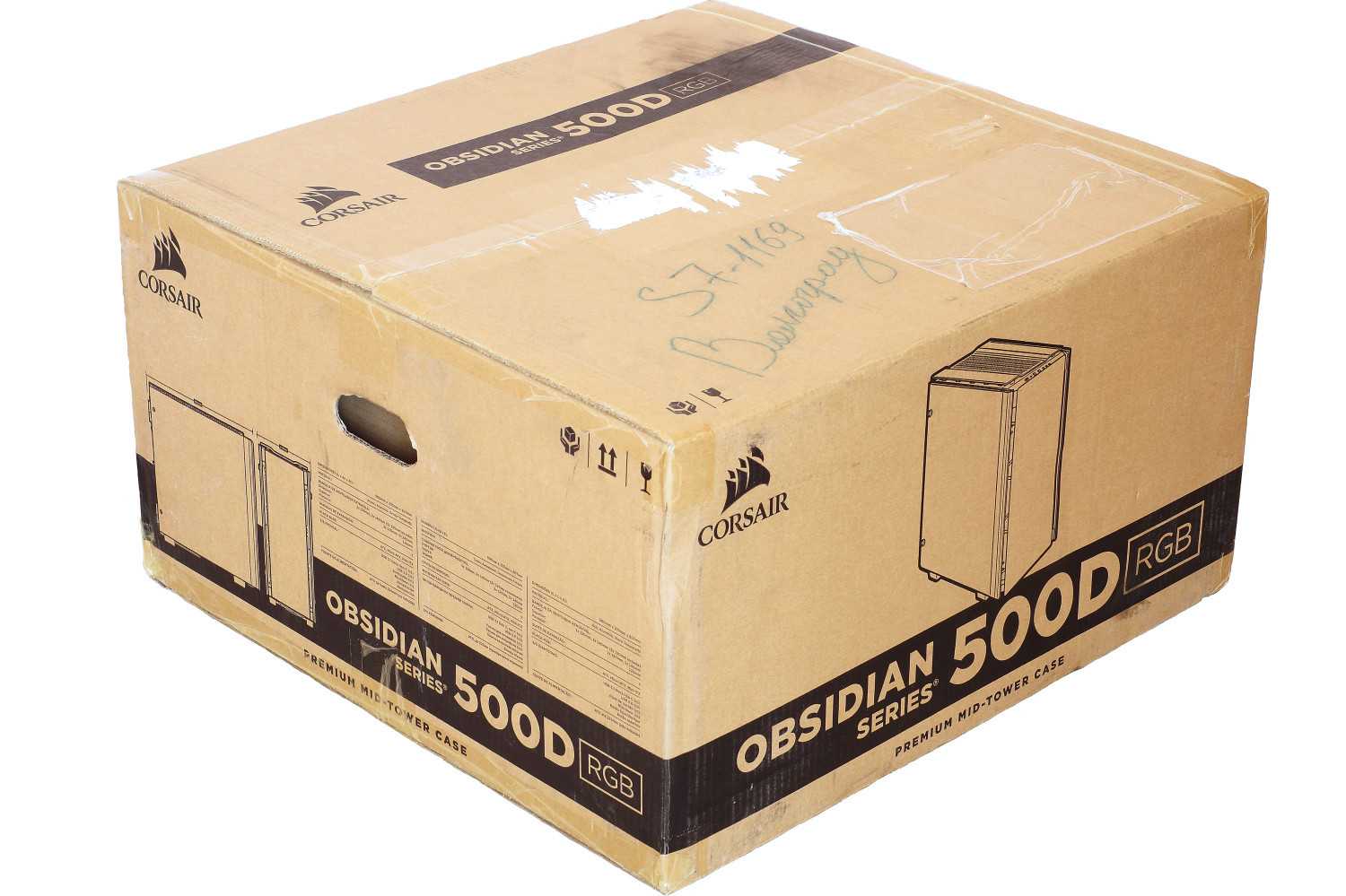
Еще на одном из торцов можно найтиособенности конструкции и указание на формат корпуса: черный, панели из стекла, комплектация тремя 120 мм вентиляторами из серии LL.
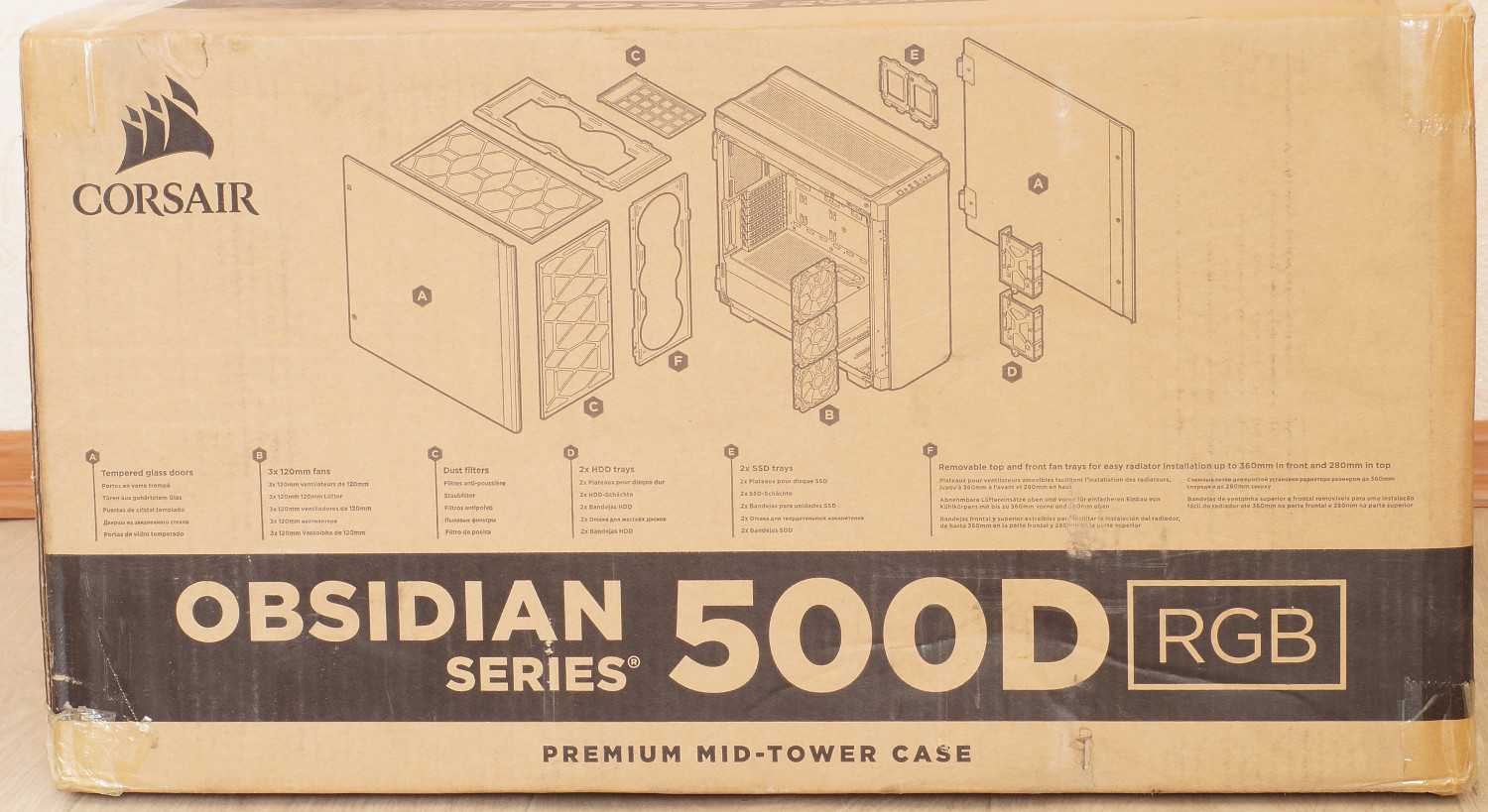
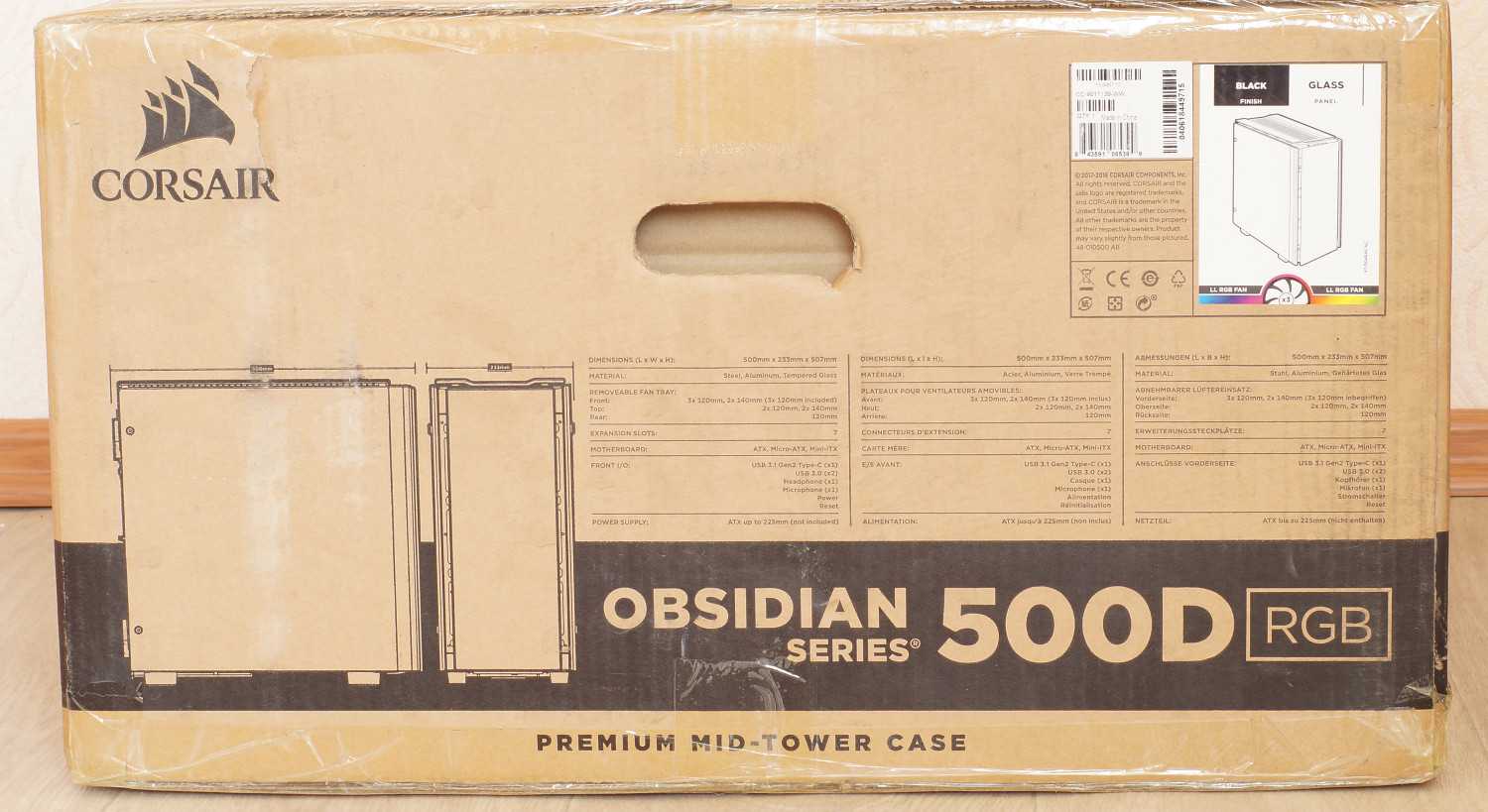
Причина такого формата кроется в размещении самого корпуса – он так же находится в горизонтальном положении и «спереди/сзади» получил приличную защиту из поролона и картона.
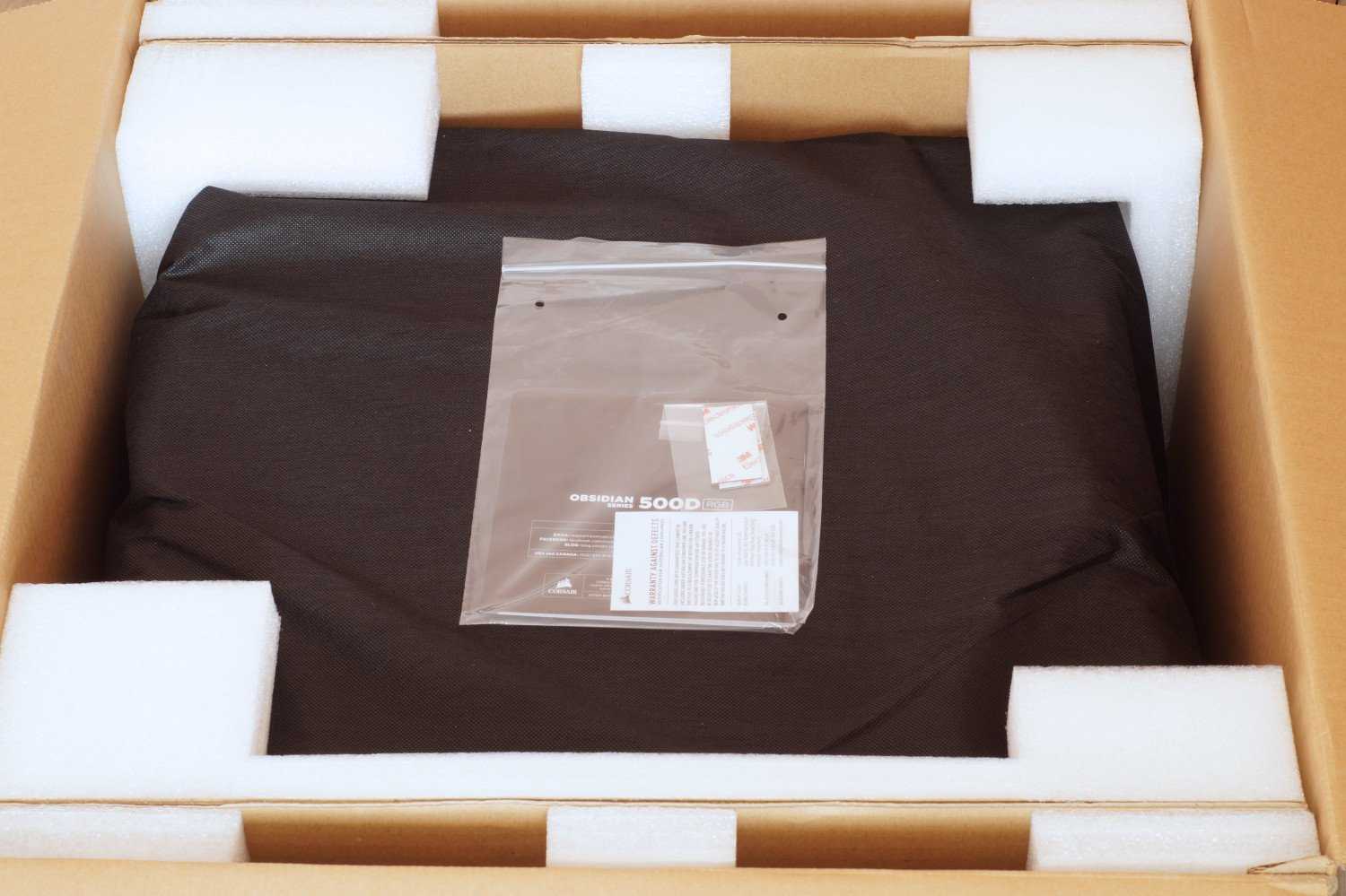
Однако неприятный момент был найден: блок подключения вентиляторов, датчиков буквально вывалился из корпуса при открытии стенки, причем в «разобранном» виде. Благо все удалось собрать, но на самом стекле внутри остались следы клейкой основы… Поэтому рекомендация: проверяйте содержимое перед покупкой.
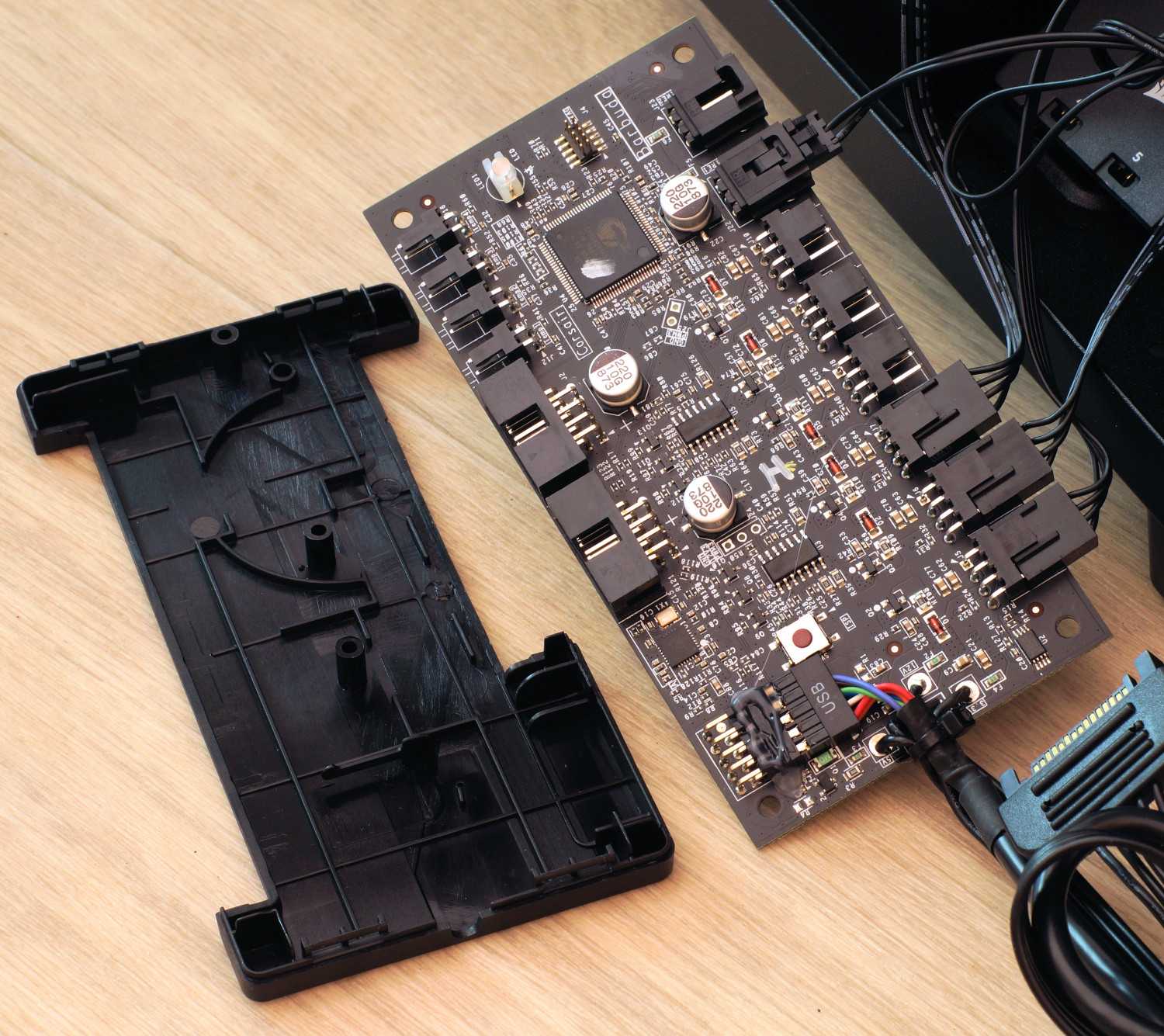
Приятный момент — комплектация находится в двух коробках. Одна содержит кабели для подключения вентиляторов, датчики температуры, вторая — одноразовые и многоразовые стяжки, набор винтов для установки вентилятора и комплектующих.
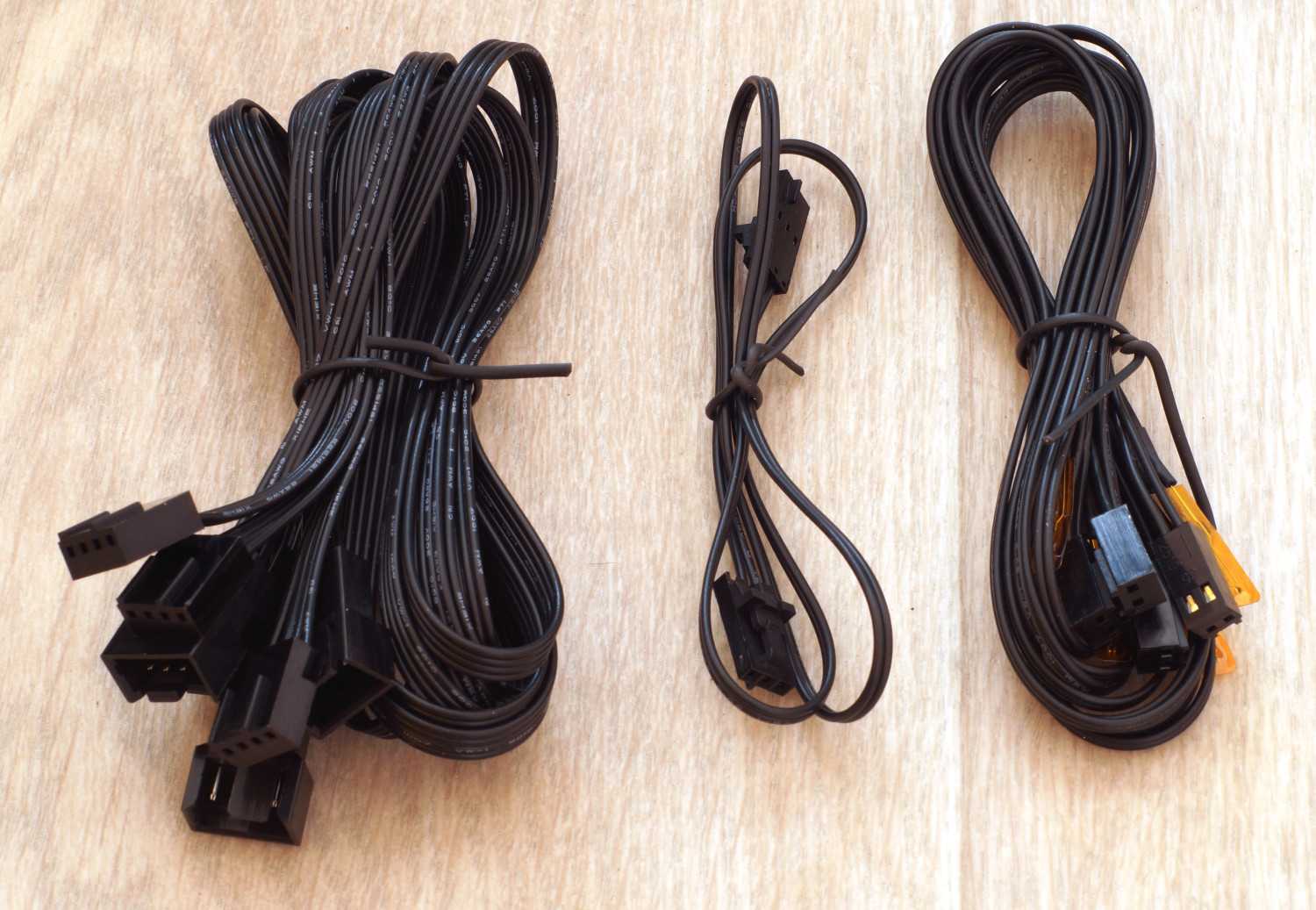
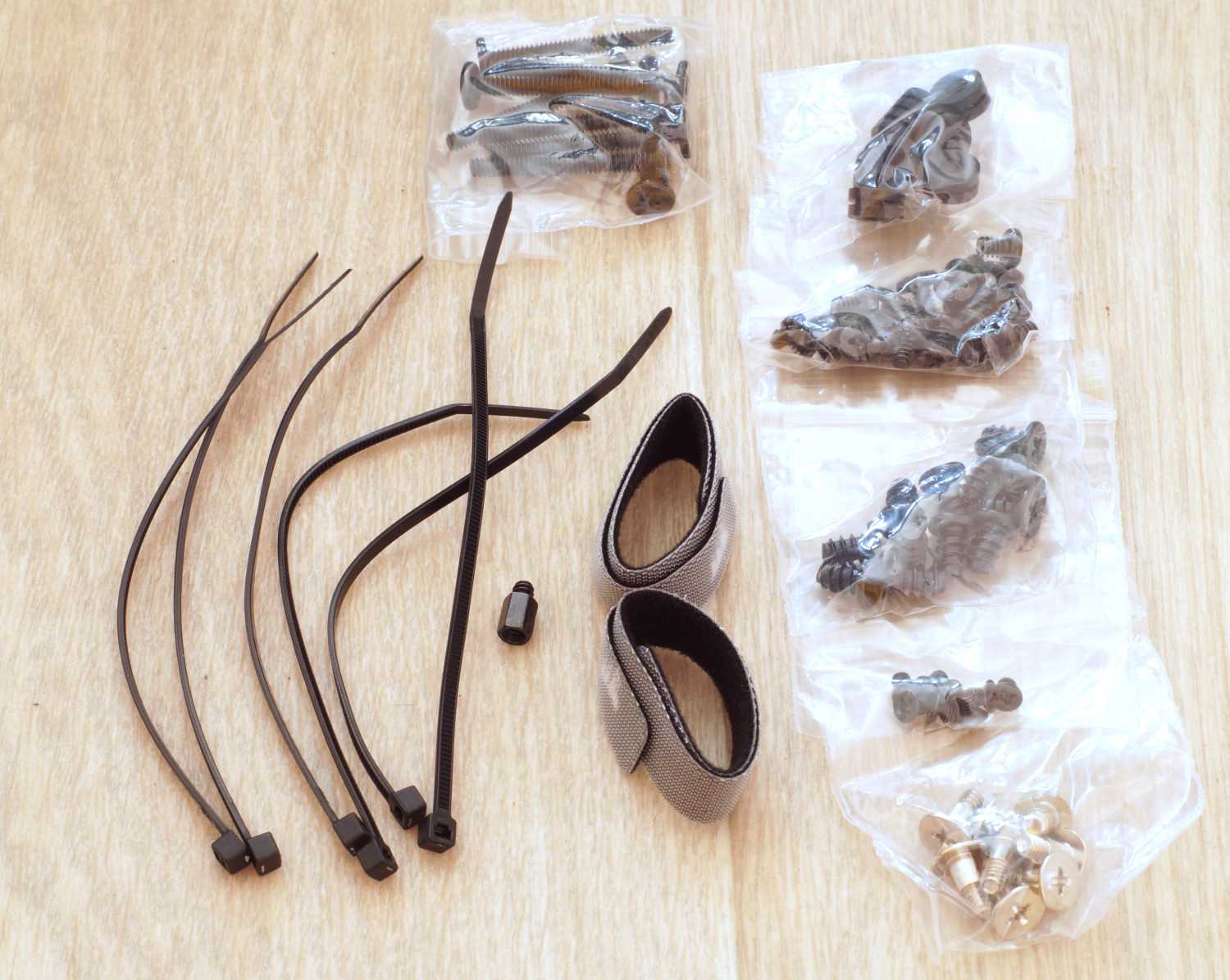
Выводы
Действительно производитель уделил дизайну Mid-Tower корпуса Corsair Obsidian 500D RGB особое внимание, сделав его выделяющимся. Как по внешнему виду, снабдив его стенками из закаленного стекла, алюминиевой верхней пластиной, эффектными и производительными 120 мм LL-вентиляторами Corsair с настраиваемой RGB-подсветкой
Так и было продумано внутреннее исполнение с открывающимися боковыми стенками, улучшена совместимость с толстыми радиаторами жидкостных систем охлаждения, коих можно установить до двух штук (240/280 мм сверху и 280/360 мм спереди), причем с простым подходом, когда они сперва крепятся на рамку, которая затем уже ставится внутрь корпуса. Помимо этого не забыта и зона укладки кабеля, который будет скрыт металлическим кожухом, улучшая эстетический вид на внутренности. Имеется и отдельный блок Commander Pro, управляемый через утилиту iCUE, позволяющий подключить до 6-и вентиляторов, до 4-х датчиков температуры и имеющий 2 канала подсветки (один используется для штатных вентиляторов). Так что придраться по виду и конструкции тяжело, ведь он проектировался как премиум-класс.
Однако без недостатков не обошлось. По стоимости корпус Corsair Obsidian 500D RGBникак не бюджетное решение и не понятно, почему производитель «сэкономил» на 120 мм вентиляторе, размещаемом на задней стенке, который бы хотелось видеть в штатной комплектации. Ведь без него эффективность все-таки несколько страдает. Еще есть моменты, которые придется учитывать при выборе комплектующих, ведь это может повлиять на вид внутри корпуса и процесс сборки. Если кабели блока питания толстые, то будет невозможно закрыть металлический кожух в месте укладки кабеля за поддоном. Использование радиаторов сверху в собранной системе может замедлить процедуру установки, так как, возможно, потребуется демонтаж материнской платы для установки кронштейна с радиатором назад в корпус.
В целом, MidTower корпус Corsair Obsidian 500D RGB определенно заслуживает внимания.
Плюсы
- Строгий и эффектный внешний вид;
- Три стенки из тонированного закаленного стекла;
- Продуманная конструкция;
- Наличие боковин-дверц для легкого доступа внутрь;
- Поддержка установки до двух радиаторов системы жидкостного охлаждения (спереди 240/280/360 мм и сверху 240/280 мм);
- Возможность мониторинга температур с 4-х датчиков;
- Наличие порта USB 3.1 тип С;
- Три предустановленных 120 мм вентилятора c RGB-подсветкой;
- Настраиваемая RGB-подсветка с помощью утилиты iCUE;
- Наличие кожуха для кабелей за поддоном;
- Простая процедура сборки.
Минусы
- Высокая цена;
- Шумная работа предустановленных вентиляторов на максимальных оборотах.
Особенности
- Невозможность закрыть кожух при укладке толстых кабелейблока питания;
- Может потребоваться демонтаж материнской платы для установки радиатора СЖО сверху.




























